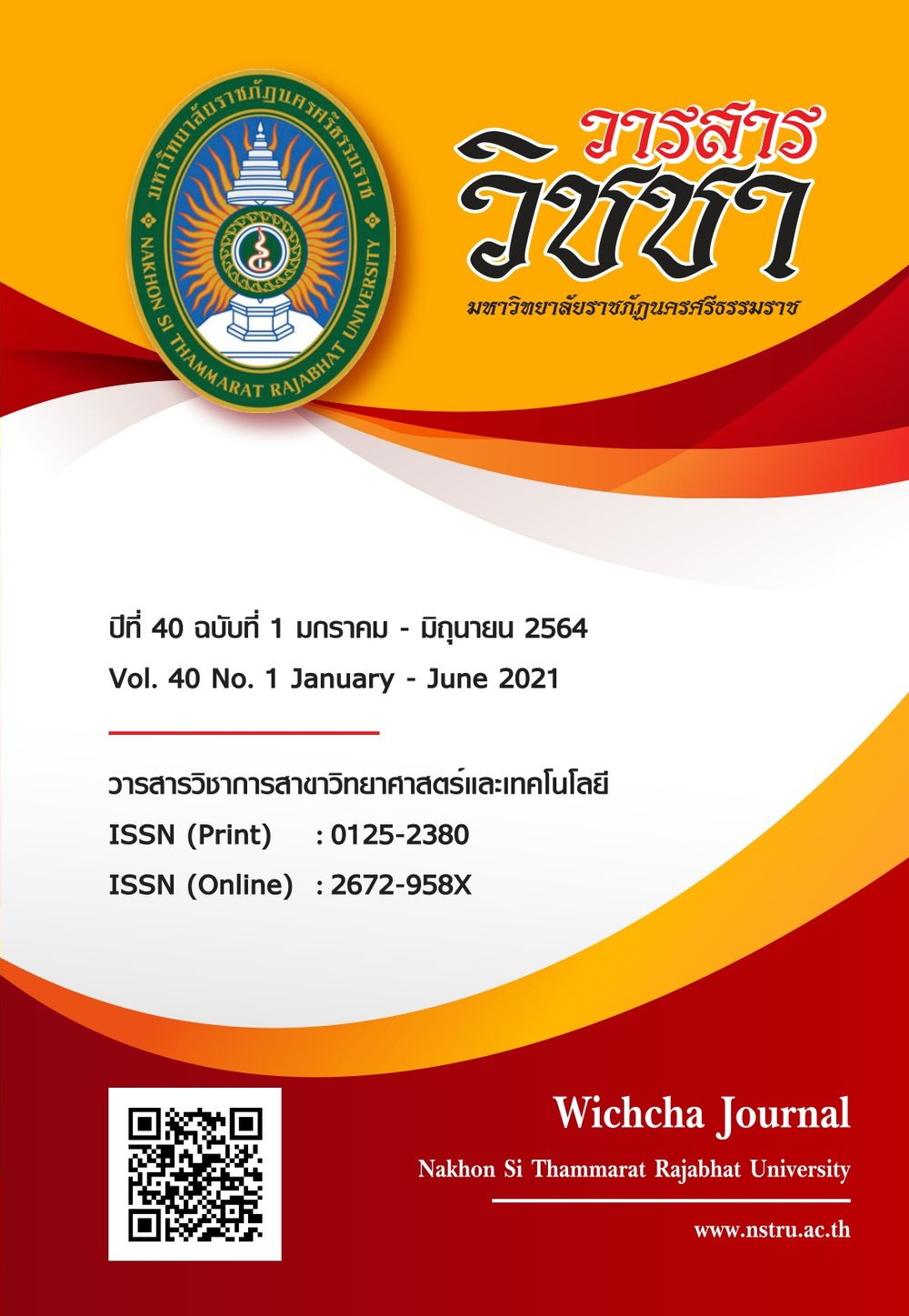Development of Biogas Production Systems from Rice Scraps by Modified Anaerobic Baffle Reactors (MABR) การพัฒนาระบบผลิตก๊าซชีวภาพจากเศษข้าวโดยถังปฏิกรณ์ไร้อากาศ แบบแผ่นกั้นประยุกต์ (MABR)
Main Article Content
Abstract
This research was demonstrated the potential of biogas production from rice scraps by the modified anaerobic baffle reactor system applied from automotive gas cylinders for biogas production and wastewater treatment. The results demonstrated the potential of the system to produced more than 20 liters of biogas per week (0.08 liters per liter of wastewater). The calculation of biogas production from the COD removal was found between 0.03 - 0.24 liters per gram of COD, tends to increase as the duration of the biogas production system is longer. This system can degrade organic matter in anaerobic condition, that high COD removal efficiency (88.9%). It was also highly efficient in removal of settable solids (99.7%), as a consequence of the sedimentation process in the modified anaerobic baffle reactor system. However, it is necessary to circulate the wastewater effluent from the system to be mixed with raw materials before being fed into the biogas production system, in order to maintain the food to microorganisms (F/M) ratio.
Article Details
เนื้อหาและข้อมูลในบทความที่ลงตีพิมพ์ในวารสารวิชชา มหาวิทยาลัยราชภัฏนครศรีธรรมราช ถือเป็นข้อคิดเห็นและความรับผิดชอบของผู้เขียนบทความโดยตรง ซึ่งกองบรรณาธิการวารสารไม่จำเป็นต้องเห็นด้วยหรือร่วมรับผิดชอบใด ๆ
บทความ ข้อมูล เนื้อหา รูปภาพ ฯลฯ ที่ได้รับการตีพิมพ์ในวารสารวิชชา มหาวิทยาลัยราชภัฏนครศรีธรรมราช ถือเป็นลิขสิทธ์ของวารสารวิชชา มหาวิทยาลัยราชภัฏนครศรีธรรมราช หากบุคคลหรือหน่วยงานใดต้องการนำข้อมูลทั้งหมดหรือส่วนหนึ่งส่วนใดไปเผยแพร่ต่อหรือเพื่อการกระทำการใด ๆ จะต้องได้รับอนุญาตเป็นลายลักษณ์อักษรจากวารสารวิชชา มหาวิทยาลัยราชภัฏนครศรีธรรมราชก่อนเท่านั้น
The content and information in the article published in Wichcha journal Nakhon Si Thammarat Rajabhat University, It is the opinion and responsibility of the author of the article. The editorial journals do not need to agree. Or share any responsibility.
References
เอนก สาวะอินทร์. (2563 ก). ระบบถังปฏิกรณ์ไร้อากาศแบบแผ่นกั้นประยุกต์จากถังบรรจุก๊าซรถยนต์สำหรับผลิตก๊าซชีวภาพและบำบัดน้ำเสีย. อนุสิทธิบัตรไทย เลขที่ 15998. กรุงเทพฯ: กรมทรัพย์สินทางปัญญา กระทรวงพาณิชย์.
เอนก สาวะอินทร์. (2563 ข). ยางในรถจักยานยนต์สำหรับเสริมประสิทธิภาพการบำบัดน้ำเสีย. อนุสิทธิบัตรไทย เลขที่ 16651. กรุงเทพฯ: กรมทรัพย์สินทางปัญญา กระทรวงพาณิชย์.
เอนก สาวะอินทร์. (2563 ค). ชุดเตาก๊าซชีวภาพ. อนุสิทธิบัตรไทย เลขที่ 16985. กรุงเทพฯ: กรมทรัพย์สินทางปัญญา กระทรวงพาณิชย์.
เอนก สาวะอินทร์ ชุตินุช สุจริต มณีรัตน์ สุทธิวงศ์ และศริญญา พูลเขาล้าน. (2558). ผลของอัตราส่วนผสมระหว่างน้ำเสียจากโรงงานผลิตเส้นขนมจีนกับน้ำเสียจากโรงงานน้ำมันปาล์มที่มีต่อการเริ่มเกิดก๊าซชีวภาพ. ใน การประชุมวิชาการระดับชาติมหาวิทยาลัยเทคโนโลยีราชมงคล ครั้งที่ 7. (หน้าที่ 312-321). นครราชสีมา: มหาวิทยาลัยเทคโนโลยีราชมงคลอีสาน.
Ahamed, A., Chen, C.L., Rajagopal, R., Wu, D., Mao, Y., Ho, I.j.R., Lim, J.W. and Wang, J.Y. (2015). Multi-phased anaerobic baffled reactor treating food waste. Bioresource Technology, 182, 239-244.
APHA, AWWA and WEF. (2012). Standard methods for the examination of water and wastewater. (22nd ed). Washington, DC: American Public Health Association (APHA), American Water Works Association (AWWA) and Water Environment Federation (WEF).
Barber, W.P. and Stuckey, D.C. (1999). The use of the anaerobic baffled reactor (ABR) for wastewater treatment: a review. Water Research, 33(7), 1559-1578.
Barati, M.R., Aghbashlo, M., Ghanavati, H., Tabatabaei, M., Sharifi, M., Javadirad, G., Dadak, A. and Soufiyan, M.M. (2017). Comprehensive exergy analysis of a gas engine-equipped anaerobic digestion plant producing electricity and biofertilizer from organic fraction of municipal solid waste. Energy Conversion and Management, 151(1), 753-763.
Diamantis, V., Eftaxias, A., Stamatelatou, K., Noutsopoulos, C., Vlachokostas, C. and Aivasidis, A. (2021). Bioenergy in the era of circular economy: Anaerobic digestion technological solutions to produce biogas from lipid-rich wastes. Renewable Energy, 168, 438-447.
Florkowski, W.J., Us, A. and Klepacka, A.M. (2018). Food waste in rural households support for local biogas production in Lubelskie Voivodship (Poland). Resources, Conservation and Recycling, 136, 46-52.
Malakahmad, A., Ezlin, A.B.N., and Ahahrom Md.Z. (2011). Study on performance of a modified anaerobic baffled reactor to treat high strength wastewater. Journal of Applied Sciences, 11(8), 1449-1452.
Mirmohamadsadeghi, S., Karimi, K., Tabatabaei, M. and Aghbashlo, M. (2019). Biogas production from food wastes: A review on recent developments and future perspectives. Bioresource Technology Reports, 7, doi: https://doi.org/10.1016/j.biteb.2019.100202.
Qi, W.K., Liu, L.F., Shi, Q., Wang, C., Li, Y.Y. and Peng, Y. (2021). Detailed composition evolution of food waste in an intermittent self-agitation anaerobic digestion baffled reactor. Bioresource technology, 320(Part A), doi: https://doi.org/10.1016/j.biortech.2020.124342.
Rajaeifar, M.A., Ghanavati, H., Dashti, B.B., Heijungs, R., Aghbashlo, M. and Tabatabaei, M. (2017). Electricity generation and GHG emission reduction potentials through different municipal solid waste management technologies: A comparative review. Renewable and Sustainable Energy Reviews, 79, 414-439.
Vlachokostas, C., Achillas, C., Agnantiaris, I., Michailidou, A.V., Pallas, C., Feleki, E. and Moussiopoulos, N. (2020). Decision support system to implement units of alternative biowaste treatment for producing bioenergy and boosting local bioeconomy. Energies, 13(9), doi: https://doi.org/10.3390/en13092306.
Westerholm, M., Liu, T. and Schnurer, A. (2020). Comparative study of industrial-scale high-solid biogas production from food waste: Process operation and microbiology. Bioresource Technology, 304, doi: https://doi.org/10.1016/j.biortech.2020.122981.
Yasin, N.H.M., Mumtaz, T. and Hassan, M.A. (2013). Food waste and food processing waste for biohydrogen production: A review. Journal of Environmental Management, 130, 375-385.
Zwain, H.M., Hassan, S.R., Zaman, N.Q., Aziz, H.A. and Dahlan, I. (2013). The start-up performance of modified anaerobic baffled reactor (MABR) for the treatment of recycled paper mill wastewater. Journal of Environmental Chemical Engineering, 1(1-2), 61-64.


